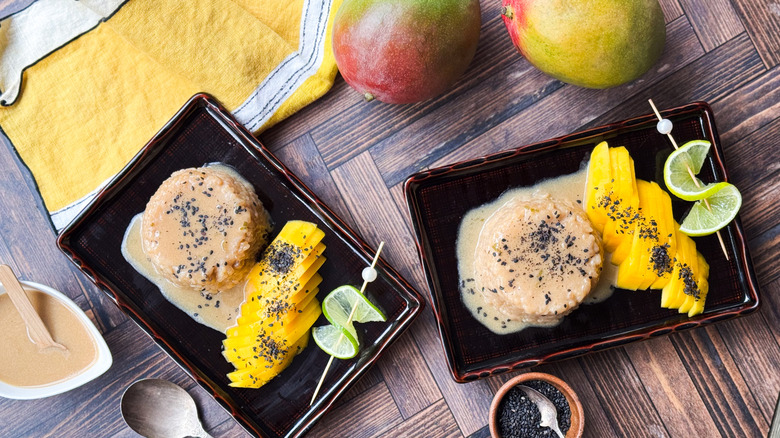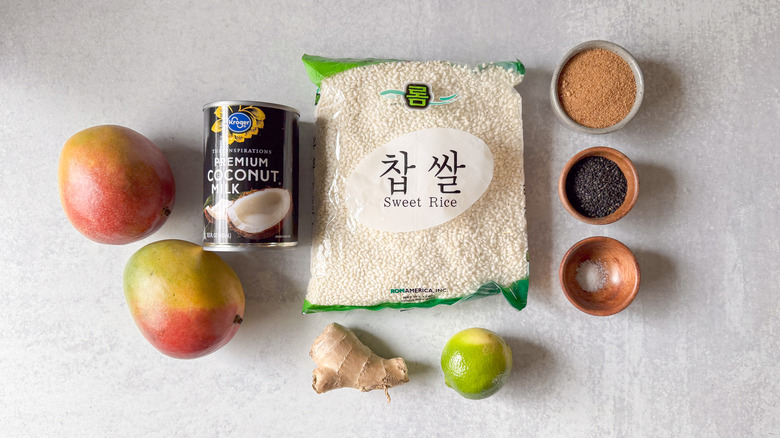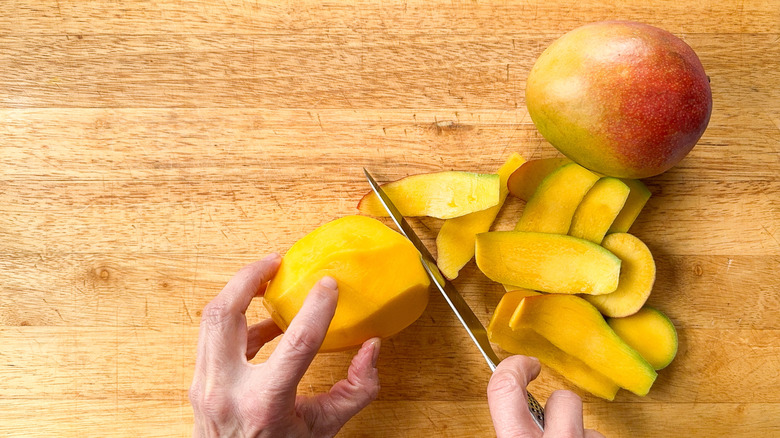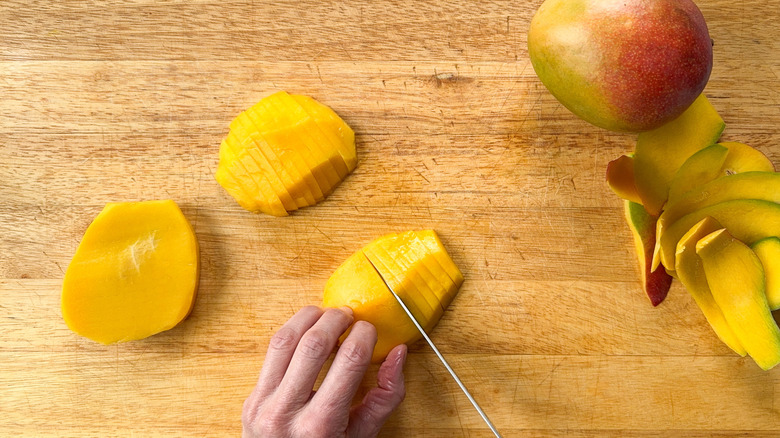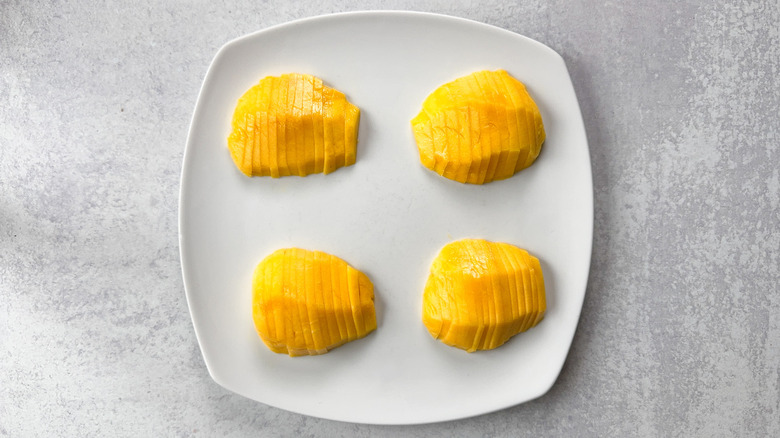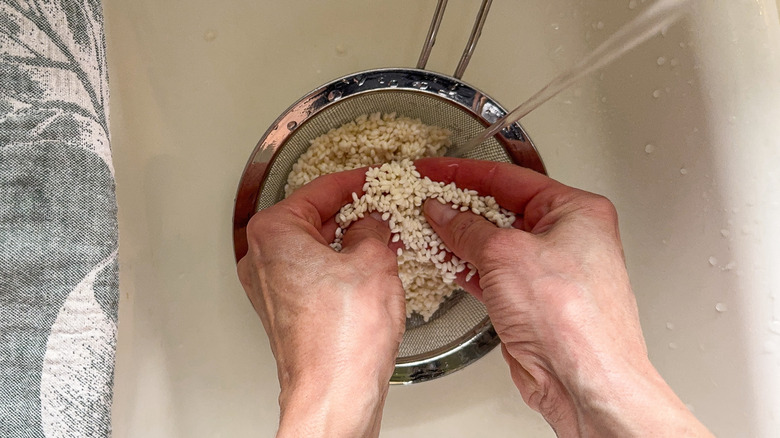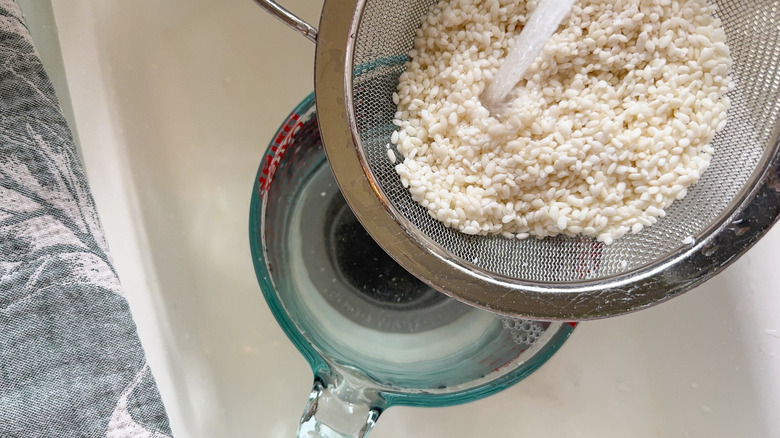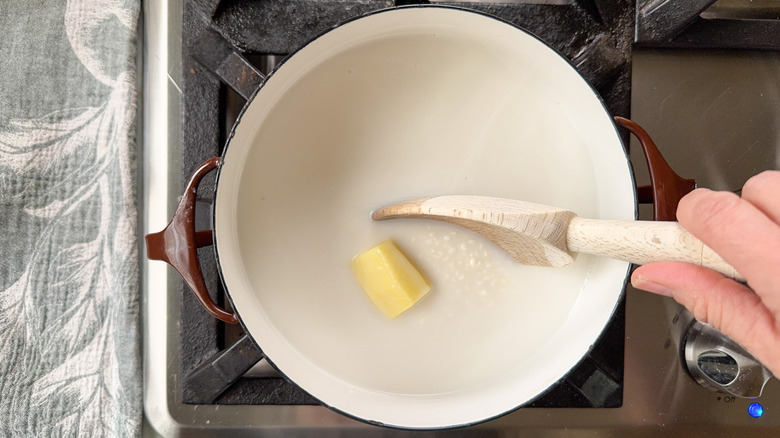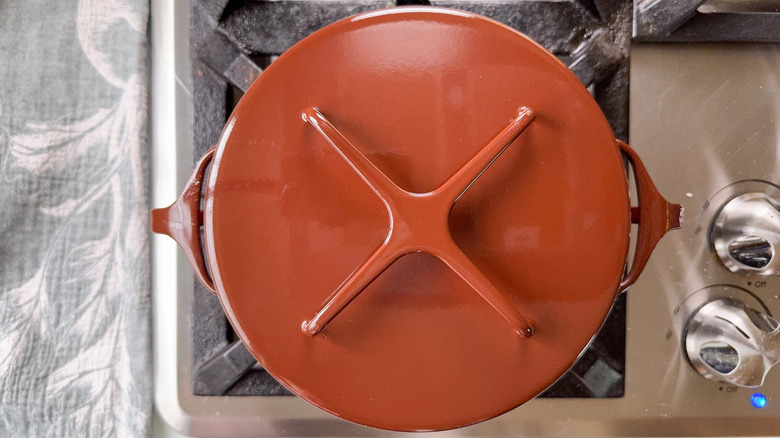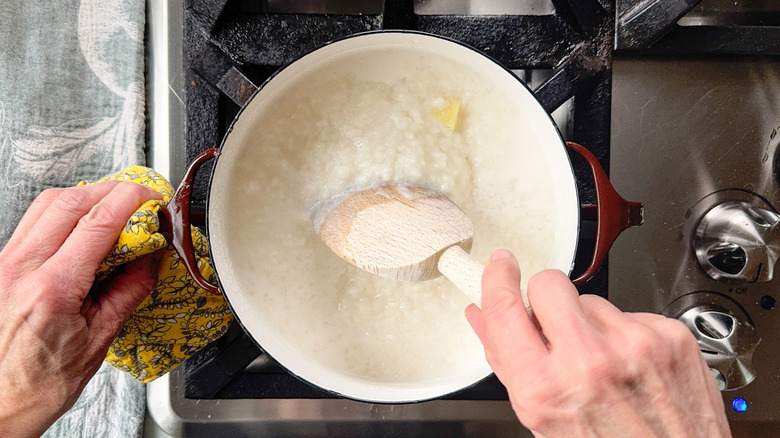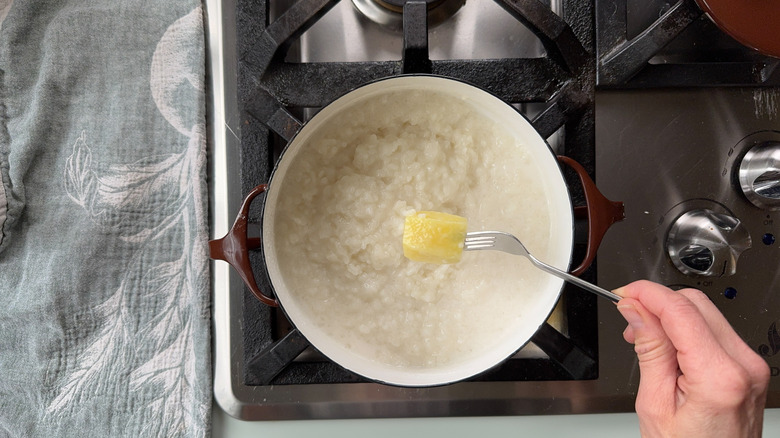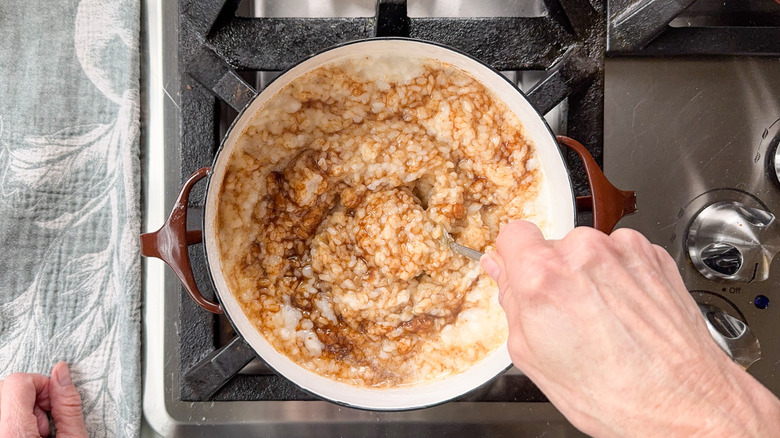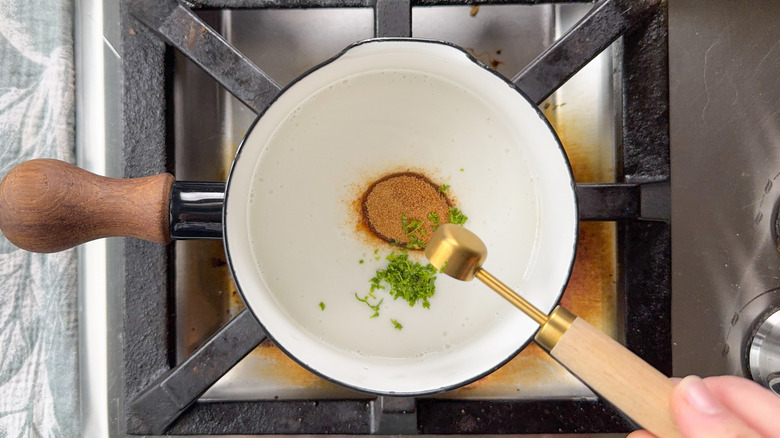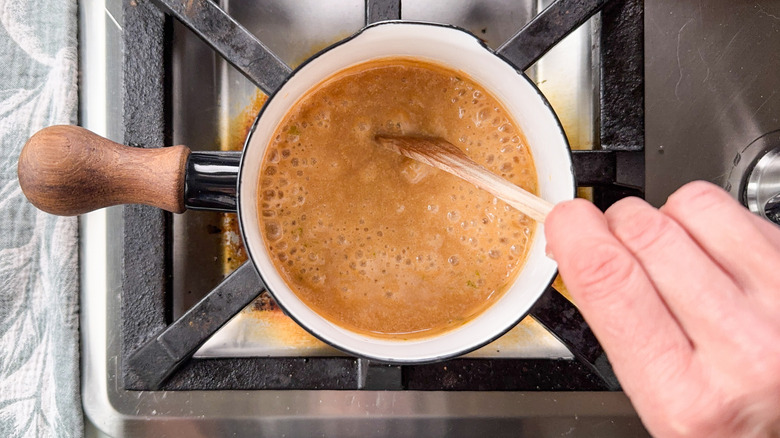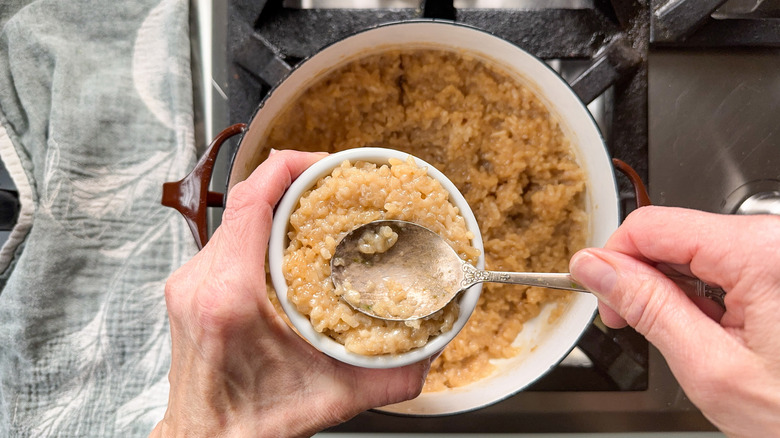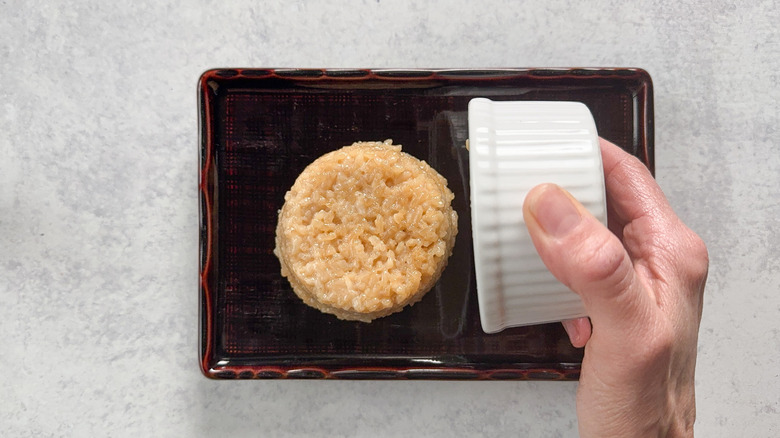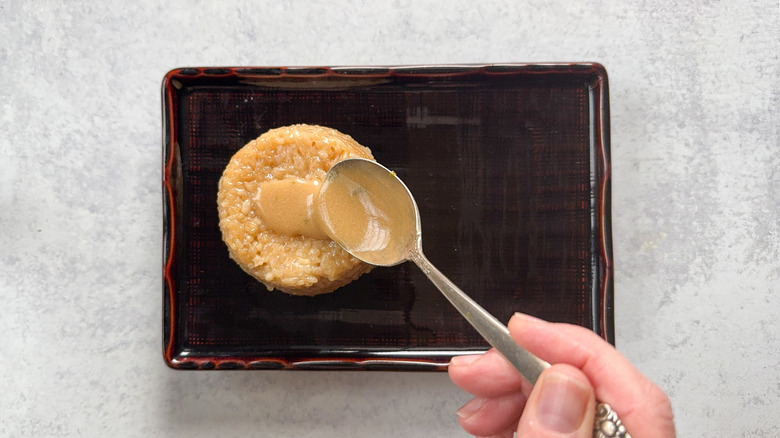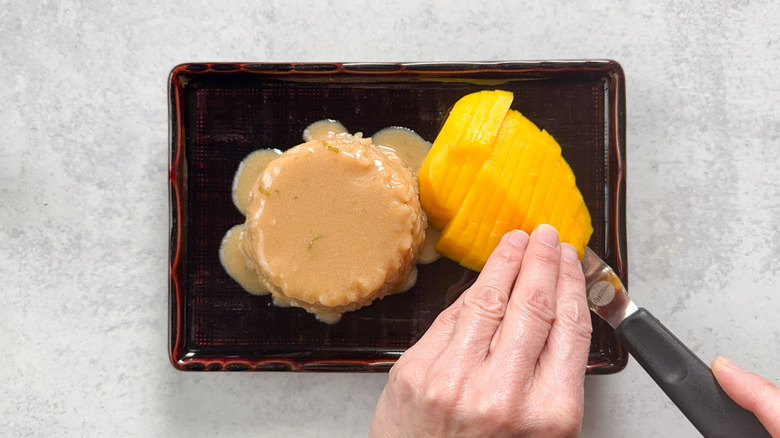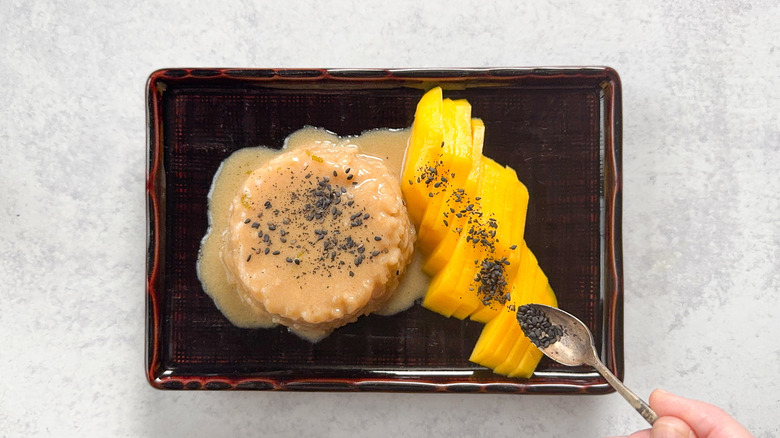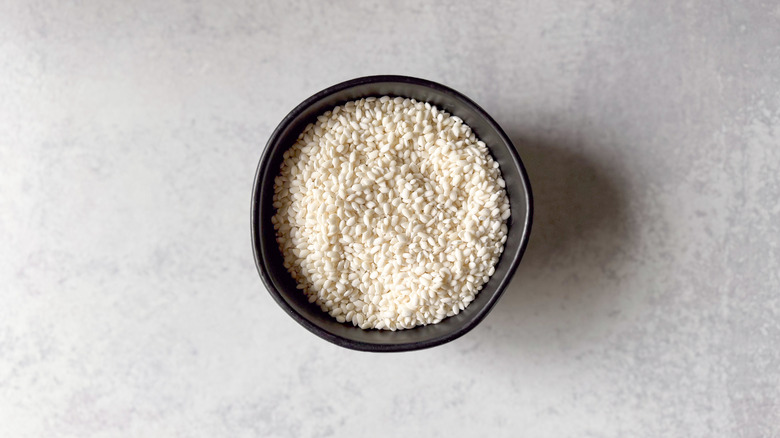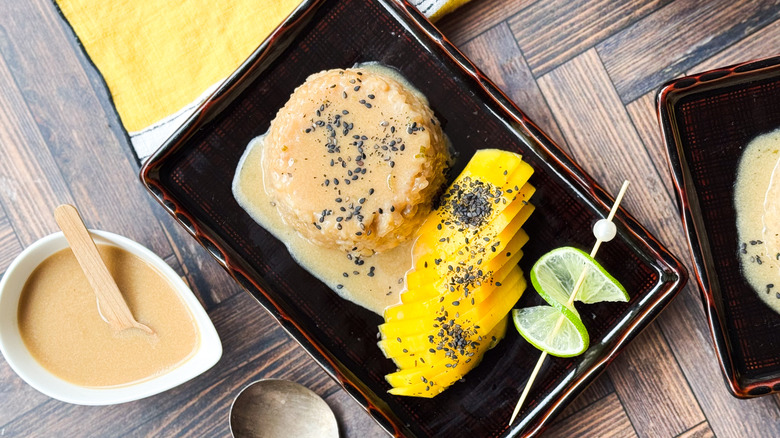Shortcut Mango Sticky Rice Recipe
We may receive a commission on purchases made from links.
Mango sticky rice is a beloved Thai treat that contrasts chewy sweet rice and creamy coconut sauce with tangy fresh mango. Although it is simple in its ingredients, mango sticky rice usually takes a bit of time to prepare. Sweet rice grains have a hard outer shell that is traditionally softened by soaking and steaming before eating. This shortcut mango sticky rice recipe — courtesy of recipe developer Julie Kinnaird — incorporates a vigorous method of massaging the sweet rice to eliminate the traditional steps of soaking and steaming the grains. In this alternate version, you will get a mini workout by rubbing the grains together while rinsing to create friction that helps break down that tough exterior. The result is a perfect-textured dessert that cooks up in a fraction of the time but with all of the delicious flavor.
Kinnaird also enhances her dessert by using coconut sugar rather than traditional white sugar. The coconut sugar has a naturally caramelized flavor that gives additional depth to both the rice and the coconut milk-based sauce. A touch of lime zest brightens up the flavors and black sesame seeds add crunch and visual flair. The full combination provides the perfect balance of soft, creamy, and juicy textures and bright, tangy, and sweet flavors.
Gather the shortcut mango sticky rice ingredients
This recipe relies on sweet rice for its sticky and creamy texture. Do not attempt this recipe with basic long or short-grain white rice, as the results will not be the same. After a good rinse and massage, the rice is combined with full-fat canned coconut milk, fresh peeled ginger root, and a touch of salt to enhance the flavor. Be sure to use a coconut milk that has minimal additives and a high fat content, rather than a "lite" variety. Coconut sugar gives this recipe a rich caramel-like flavor, and it is added to both the rice and to the sauce. Lime zest gives the sauce a boost of brightness and pairs nicely with the fresh mango sliced up on the side. Kinnaird likes using black sesame seeds for a dramatic visual statement, but white sesame or a combo of the two work equally well.
Step 1: Peel the mangoes
Using a sharp knife, cut the ends and peel from the mangoes, following the contour of the fruit.
Step 2: Slice the mangoes
Cut the flesh away from the pits and then cut crosswise into slices.
Step 3: Transfer the mango slices to a plate
Carefully transfer the prepared mango to a plate and set aside.
Step 4: Wash and massage the rice
Place the rice in a fine mesh sieve and rinse with gently running water while massaging the grains for several minutes to break down the outer layer of the rice kernels.
Step 5: Rinse the rice
Rinse the rice until the water runs clear.
Step 6: Combine the rice, coconut milk, and ginger
Add the rinsed rice to a medium saucepan and add 1 cup of the coconut milk, 1 cup water, the ginger root, and salt.
Step 7: Cover the rice
Bring to a gentle simmer over medium-low heat, then cover and cook for 5 minutes.
Step 8: Uncover and stir the rice
Remove the lid and stir the rice to prevent it from becoming stuck to the bottom of the pan. Replace the lid and cook 5-7 minutes longer until the rice is tender and most of the liquid is absorbed.
Step 9: Remove the ginger root
Remove the ginger root from the pot.
Step 10: Add coconut sugar to the rice
Remove from the heat and add 4 tablespoons of coconut sugar to the rice. Set aside to cool slightly.
Step 11: Start the sauce
In a small sauce pan, combine the remaining coconut milk, remaining coconut sugar, and lime zest.
Step 12: Cook and stir until thickened
Cook and stir over medium heat for about 5 minutes until slightly thickened and bubbly.
Step 13: Pack the rice into molds
Use a scoop or spoon to pile some of the warm sticky rice into an oiled 4-ounce ramekin or other similar vessel, packing the rice down.
Step 14: Unmold the sticky rice
Invert the ramekin onto a serving plate and gently shake to loosen the rice mold.
Step 15: Spoon some of the sauce over the sticky rice
Spoon a small amount of the coconut milk sauce on top of the rice so that it runs down the sides.
Step 16: Add some sliced mango
Add some of the sliced mango to the plate.
Step 17: Garnish and serve
Garnish with the sesame seeds and serve immediately.
Shortcut Mango Sticky Rice Recipe
Mango sticky rice is a tasty Thai dessert with the perfect combination of textures and flavors, and our easy version avoids the long soaking and steaming steps.
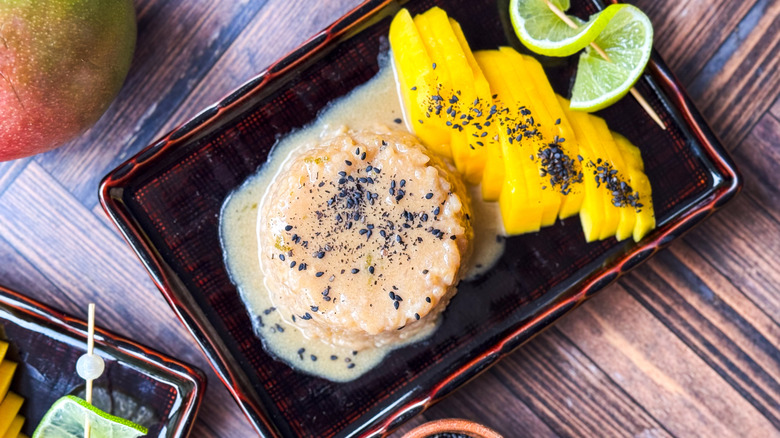
Ingredients
- 2 large ripe mangoes
- 1 cup sweet rice (glutinous rice or sticky rice)
- 1 (14-ounce) can full-fat coconut milk, well-stirred, divided
- 1 (2-inch) piece fresh ginger root, peeled
- ¼ teaspoon sea salt
- 6 tablespoons coconut sugar, divided
- ½ teaspoon finely grated lime zest
- 2 teaspoons black sesame seeds
Directions
- Using a sharp knife, cut the ends and peel from the mangoes, following the contour of the fruit.
- Cut the flesh away from the pits and then cut crosswise into slices.
- Carefully transfer the prepared mango to a plate and set aside.
- Place the rice in a fine mesh sieve and rinse with gently running water while massaging the grains for several minutes to break down the outer layer of the rice kernels.
- Rinse the rice until the water runs clear.
- Add the rinsed rice to a medium saucepan and add 1 cup of the coconut milk, 1 cup water, the ginger root, and salt.
- Bring to a gentle simmer over medium-low heat, then cover and cook for 5 minutes.
- Remove the lid and stir the rice to prevent it from becoming stuck to the bottom of the pan. Replace the lid and cook 5-7 minutes longer until the rice is tender and most of the liquid is absorbed.
- Remove the ginger root from the pot.
- Remove from the heat and add 4 tablespoons of coconut sugar to the rice. Set aside to cool slightly.
- In a small sauce pan, combine the remaining coconut milk, remaining coconut sugar, and lime zest.
- Cook and stir over medium heat for about 5 minutes until slightly thickened and bubbly.
- Use a scoop or spoon to pile some of the warm sticky rice into an oiled 4-ounce ramekin or other similar vessel, packing the rice down.
- Invert the ramekin onto a serving plate and gently shake to loosen the rice mold.
- Spoon a small amount of the coconut milk sauce on top of the rice so that it runs down the sides.
- Add some of the sliced mango to the plate.
- Garnish with the sesame seeds and serve immediately.
Nutrition
| Calories per Serving | 576 |
| Total Fat | 23.0 g |
| Saturated Fat | 19.1 g |
| Trans Fat | 0.0 g |
| Cholesterol | 0.0 mg |
| Total Carbohydrates | 92.0 g |
| Dietary Fiber | 3.6 g |
| Total Sugars | 46.8 g |
| Sodium | 142.9 mg |
| Protein | 7.3 g |
How is sweet rice different from regular white rice?
Sweet rice, also known as sticky rice or glutinous rice, is used throughout Asia for both desserts and savory dishes. Sweet rice differs from basic white rice as it has a high level of amylopectin, a starch that gives sweet rice its unique ultra-sticky texture. Most other types of rice contain amylopectin along with another starch called amylose, and the level of "stick" will depend on the proportions of those two starches.
Although it is naturally gluten-free, sweet rice is referred to as "glutinous rice" due to its stickiness rather than gluten content. While it is subtle, the flavor of sweet rice is indeed lightly sweet, making it a natural choice for desserts, but also allowing it to pair with savory flavors. The easily clumping grains make sweet rice easy to eat with chopsticks and perfect for molding into shapes or cakes. Sweet rice grains do have a much tougher outer layer than other types of white rice. Proper rinsing and either massaging or steaming the grains is essential for achieving the best taste and texture.
Can I prepare mango sticky rice in advance, and what is the best temperature to serve it?
This shortcut mango sticky rice has a few steps that can be done in advance for ease of serving. First, the sauce can be made up to 3 days ahead of serving and stored in a glass jar in the refrigerator until ready to use. Just gently reheat the sauce in a pan or on medium heat in a microwave. Overheating can cause the sauce to separate and lose its smooth texture. The mangoes can also be peeled and sliced up to a day in advance. Just be sure to keep them tightly wrapped in plastic and refrigerated until ready to serve.
While the rice is best just after cooking, there are a couple of methods for rewarming if cooked in advance. Try adding just a small amount of boiling water to the rice in a pot, then gently warming it over low heat. This will help to loosen up the texture. Try not to stir the rice too much, as the grains will begin to break apart. You can also microwave the rice in a covered container on a medium-low heat setting. While serving the dessert warm is traditional, shortcut mango sticky rice tastes great at a variety of temperatures: Room temperature or even chilled versions will still have a delicious flavor.
